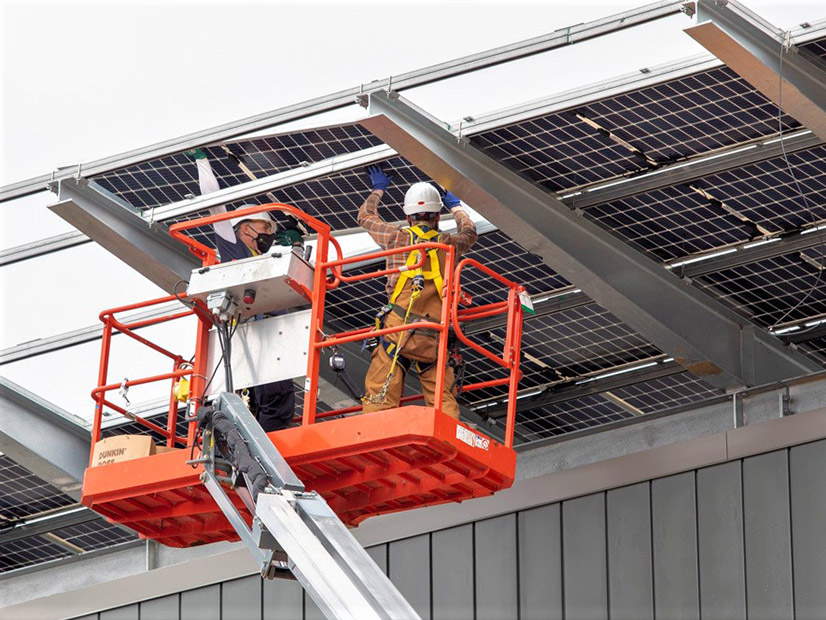Vermont energy officials will be taking the state’s comprehensive energy plan (CEP) update in a new direction this year by giving it a strategic focus.
“We’re going to look at the tradeoffs among different policies, milestones for identifying success and the need for modification,” said Ed McNamara, director of the Regulated Utility Planning Division at the Vermont Department of Public Service (DPS).
As part of the update, the department will identify uncertainties that could affect state policy success, McNamara said during the first of four CEP regional outreach sessions on June 1.
The state’s current plan, which was completed in 2016, is based on meeting a 90% renewable energy target by 2050 through 300 recommendations across the heating, transportation and electric sectors. The update will keep the 90% target while looking instead at potential market fluctuations in those sectors and how the state might need to accommodate them in the future, McNamara said.
In addition, the update will make recommendations for enhanced energy planning and climate and renewable energy pathways and recognize standards for regional energy planning that were developed after the state completed the 2016 plan.
DPS also must ensure that the update aligns with work currently underway by the Vermont Climate Council to develop the state’s first climate action plan. The 2020 Global Warming Solutions Act directs the council to complete that action plan by the end of this year. It also sets greenhouse gas reduction targets to 26% below 2005 levels by 2025 and 40% and 80% below 1990 levels by 2030 and 2050, respectively.
There is “significant overlap” between the energy and climate plans, McNamara said.
The primary responsibility of the climate plan is to identify cost-effective GHG reduction measures, going beyond energy to address other issues such as sequestration and non-energy sector emissions. The energy plan, however, will meet the state’s GHG reduction requirements “in an affordable manner while maintaining electric system reliability,” he said.
DPS expects to release a draft plan in September and publish the final plan in January. It will hold three more regional stakeholder meetings to help inform the plan.
Regional Planning
During its first outreach session, DPS heard from three regional planning commissions in southeastern Vermont about their energy plans and challenges.
All three regions have prioritized weatherization in their plans, but representatives say on-the-ground progress is not moving quickly enough.
For the Mount Ascutney Regional Commission (MARC), measuring the success of weatherization efforts is difficult.
“It’s really hard, it turns out, to quantify or to categorize what weatherization means,” Otis Munroe, MARC’s assistant planner, said. “There are a lot of DIY and incremental projects … that make it much more difficult to track where we are and what’s working and what isn’t.”
A high proportion of the region’s housing stock is old, making many homes more expensive to weatherize and heat, he said.
The Two Rivers-Ottauquechee Regional Commission (TRORC) says its data show low weatherization rates for the area.
“Our region has over 29,000 residential units, and of those, only 144 were weatherized as of 2019,” Victoria Littlefield, regional planner at TRORC, said. The progress, she added, may be underestimated because weatherization data is so hard to track, but the region is “definitely behind.”
Mount Ascutney and Two-Rivers also are struggling with residential building energy code enforcement.
“While there are residential building energy standards in practice, they are not being followed in most situations,” Geoff Martin, intermunicipal regional energy coordinator at TRORC, said. “Our towns don’t have a way of enforcing the standards.”
Building a strategy for enforcement at the state level, he said, would help increase compliance.
Local Planning
Regional planning commissions in the state also work directly with municipal energy committees to guide local planning efforts. They see a need for better state-level support at the local level.
In its outreach to the region’s towns, the Two-Rivers commission has received feedback from local officials that state data for solar and wind potential is not accurate.
“Those maps are created based on a formula that DPS came up with, but … the formula uses state data layers that aren’t updated as often, so it’s not quite reflective of what’s happening on the ground,” Littlefield said. She recommended that the state consider updating those layers so towns can have a “better picture” for siting renewable generation.
And the Windham Regional Commission has found that local energy committees could use some funding.
“Our rural communities are often reliant on volunteers for energy committees, and they have little time [or expertise] to … achieve their energy reduction goals,” Margo Ghia, regional planner of the commission, said.
Funding for local-level energy planners, educational opportunities and access to better data would go a long way in helping committees in their work, she said.
